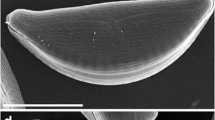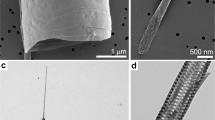Summary
Wall formation in Navicula pelliculosa was studied in Si-starvation synchrony. Electron microscopy of walls, prepared by mechanical shaking, indicated that they were free, of cytoplasmic contamination. Removal of the frustule, using HF, indicated that a higher ratio of organic material to silica occurred in the girdle bands below the punctae and in the raphe region. The organic material was investigated following incorporation of 14C. Material added to newly formed walls prior to and during Si-deposition contained more radioactivity in amino acids than in other constituents. Once Si-uptake ceased, material with increased fucose and xylose content became labelled. Secondary material, the main labelled constituents of which were mannose and glucoronic acid, was added to old walls at all times. Si-uptake was investigated using 31Si. The rate of assimilation increased during the first hour following addition, remained constant over the next three hours, and then decreased markedly during the separation of daughter cells. Varying amounts of 31Si could be extracted from intact cells, using hot or cold solvents. These results are discussed in relation to the sequence in which proteinaceous material and polysaccharides are formed during morphogenesis of the diatom wall.
Similar content being viewed by others
References
Ambe, K. S., and A. L. Tappel: Improved separation of amino acids with a new solvent system for two-dimensional paper chromatography. J. Chromatog. 5, 546–548 (1961).
Coombs, J., W. M. Darley, O. Holm-Hansen, and B. E. Volcani: Studies on the biochemistry and fine structure of silica shell formation in diatoms. Chemical composition of Navicula pelliculosa during silicon-starvation synchrony. Plant Physiol. 42, 1601–1606 (1967a).
—, P. J. Halicki, O. Holm-Hansen, and B. E. Volcani: Studies on the biochemistry and fine structure of silica shell formation in diatoms. Changes in concentrations of nucleosidetriphosphates in silicon-starvation synchrony of Navicula pelliculosa (Bréb.) Hilse. Exp. Cell Res. 47, 315–328 (1967b).
—, C. Spanis, and B. E. Volcani: Studies on the biochemistry and fine structure of silica shell formation in diatoms. Photosynthesis and respiration in siliconstarvation synchrony of Navicula pelliculosa. Plant Physiol. 42, 1607–1611 (1967c).
—, J. A. Lauritis, W. M. Darley, and B. E. Volcani: Studies on the biochemistry and fine structure of silica shell formation in diatoms. V. Effects of colchicine on wall formation in Navicula pelliculosa (Bréb.) Hilse. Z. Pflanzenphysiol. 59, 124–152 (1968).
—, and B. E. Volcani: Studies on the biochemistry and fine structure of silica shell formation in diatoms. Silicon induced metabolic transients in Navicula pelliculosa (Bréb.) Hilse. Planta (Berl.) 80, 264–279 (1968).
Lewin, J. C.: Silicon metabolism in diatoms. III. Respiration and silicon uptake in Navicula pelliculosa. J. gen. Physiol. 39, 1–10 (1955).
— B. E. Reimann, W. F. Busby, and B. E. Volcani: Silica shell formation in synchronously dividing diatoms. In: Cell Synchrony Studies in Biosynthetic Regulation (I. L. Cameron and G. M. Padilla, eds.), p. 167–188. New York and London: Academic Press 1966.
Luft, J. H.: Improvements in epoxy resin embedding methods. J. biophys. biochem. Cytol. 9, 409–414 (1961).
Reimann, B. E., J. C. Lewin, and B. E. Volcani: Studies on the biochemistry and fine structure of silica shell formation in diatoms. I. The structure of the cell wall of Cylindrotheca fusiformis Reimann and Lewin. J. Cell Biol. 24, 39–55 (1965).
Reimann, B. E., J. C. Lewin, and B. E. Volcani Studies on the biochemistry and fine structure of silica shell formation in diatoms. II. The structure of the cell wall of Navicula pelliculosa (Bréb.), Hilse. J. Phycol. 2, 74–84 (1966).
Reynolds, E. S.: The use of lead citrate at high pH as an electron opaque stain in electron microscopy. J. Cell Biol. 17, 208–212 (1963).
Sabatini, D. D., K. Bensch, and R. J. Barrnett: Cytochemistry and electron microscopy; the preservation of cellular ultrastructure and enzymic activity by aldehyde fixation. J. Cell Biol. 17, 19–58 (1963).
Stempak, J. G., and R. T. Ward: An improved staining method for electron microscopy. J. Cell Biol. 22, 697–701 (1964).
Werner, D.: Über reversible Speicherung von Kieselsäure in Cyclotella cryptica. Arch. Mikrobiol. 57, 43–50 (1967).
—, u. A. Pirson: Hemmung der Chlorophyllsynthese und der NADP+-abhängigen Glycerinaldehyd-3-Phosphat-Dehydrogenase durch Germaniumsäure bei Cyclotella cryptica. Arch. Mikrobiol. 57, 51–60 (1967).
Author information
Authors and Affiliations
Rights and permissions
About this article
Cite this article
Coombs, J., Volcani, B.E. Studies on the biochemistry and fine structure of silica-shell formation in diatoms. Planta 82, 280–292 (1968). https://doi.org/10.1007/BF00398205
Received:
Issue Date:
DOI: https://doi.org/10.1007/BF00398205




